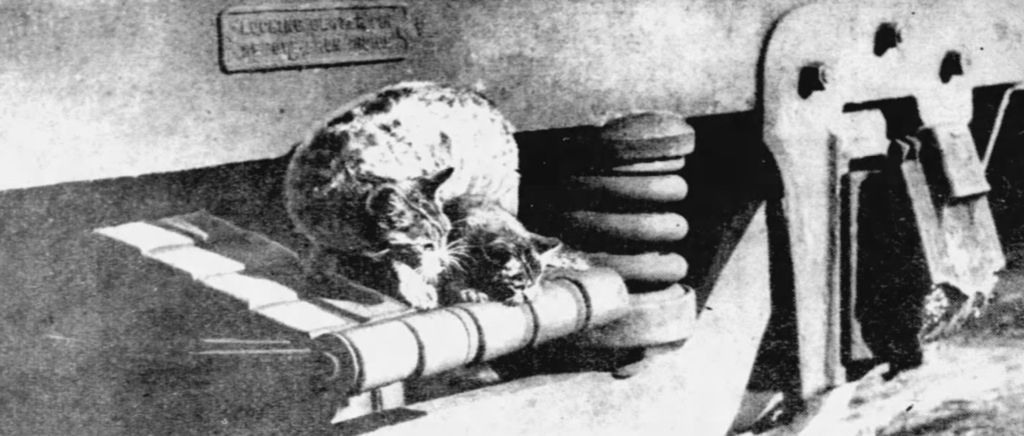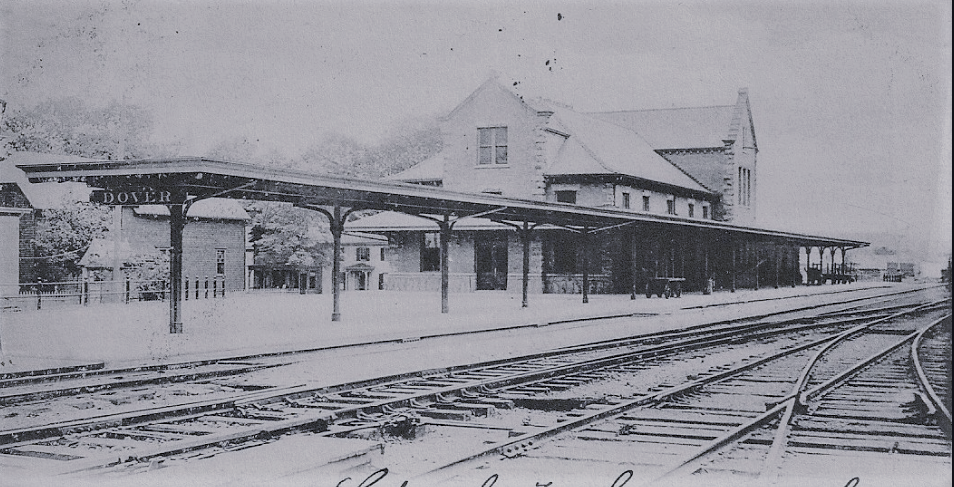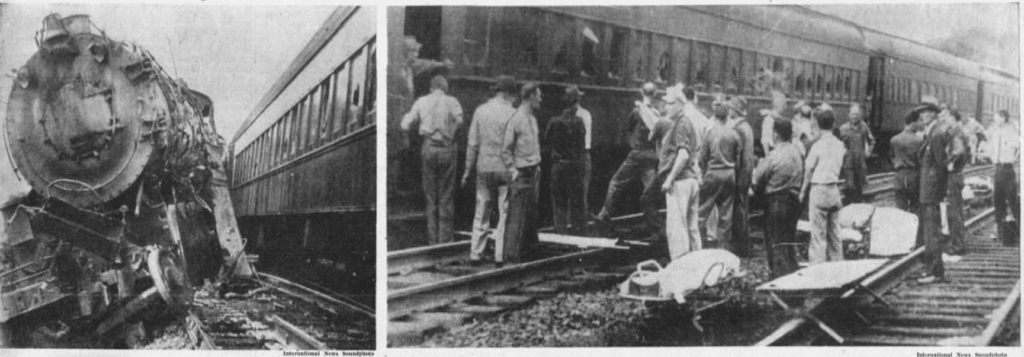
On January 8, 1933, Betty, chief mouser of the Lackawanna Terminal at Hoboken, NJ, hitched a train ride on the Lackawanna Limited to Dover, N.J. It was her first train trip since joining the crew at Hoboken four or five years earlier.
The story of Betty’s train adventure was covered in all the New York-New Jersey metro area newspapers and in papers as far away as California and Miami.

As the Miami Herald noted, Betty not only had a weekend adventure “the like of which few cats are privileged to experience,” she also disrupted the entire Lacakwanna Railroad system with her feline antics.
“Betty’s a different kind of cat,” station-master Henry Byrnes explained to the press. “I don’t understand her acting up like this, without warning. I guess she got a touch of that old itching foot, like most humans get sometimes.”
Betty’s Adventure on the Lacakawanna Limited
According to the story, Betty chose the Lackawanna Limited, the crack daylight train to Buffalo, for her excursion. Leaving her two kittens behind, she sauntered past gateman Al Brody and jumped on the forward truck of the fourth coach like a seasoned hobo. (The truck is the structure in which the train’s axles and wheels were attached).
Unlike Commissioner, the police cat that jumped off the Brooklyn Bridge and took a train to Utica, New York, in 1907, Betty didn’t quite make it that far.

Thirteen minutes later, the baggage men at Newark completely missed her as they loaded the train. The train then sped passed Morristown, where, at 11:07 a.m., a baggage man saw a bundle of gray fur curled up on the forward truck, a few trains behind the locomotive.
The Morristown crew telegraphed ahead to Dover to let them know that the train had a stowaway. Dover was a flag stop for the Lackawanna Limited, meaning if there were no passengers, the train would keep speeding westward. On this day, baggage man Frank Batson raised the flag and the train rolled to a stop, 37 miles from Hoboken.
After a quick search, Batson found Betty, her whiskers pushed back a bit by the high winds and her fur a bit ruffled, but otherwise as calm as can be. According to her rescuers, she looked content and ready to continue her voyage.
Betty’s composure changed when the men tried to grab her. “You wouldn’t have known her for the quiet, respectable cat she was around her home station,” the men told the press. “She put her back up, took a hold on the truck with her claws and spit, most disrespectful. Then she hopped off the train and ran away.”

When news of Betty’s escape reached station-master Henry Byrnes in Hoboken, he frantically called for help. Off-duty trainmen were notified to join in the search, as were the Dover police. All that night, the men searched the Dover yards with lanterns.
Two days later, the men found Betty in a nearby lumberyard. When the No. 6 train from Chicago came through, the train was flagged down to take a passenger. The conductor and porters jumped off, ready to assist the passenger with his or her baggage.
“Great snakes!” the conductor shouted as Betty was placed in his care. The hobo mouser returned to Hoboken in the baggage compartment.
When Betty returned back home, the men held a grand reception for her. Al Brody, the gateman who let the cat pass him on Sunday morning, said he felt very bad about failing to spot her.

“If she were a kitten with flighty ideas, you might explain it just that way,” Brody said. “But you take a cat that’s been a widow eight times, like she has, and try to figure it out, and you’ll have to sit up nights and maybe get a tower job with plenty of time for thinkin’, and still get nowhere.”
The press had a lot of fun with Betty’s story. One newspaper suggested the much-married cat galivanted off to Buffalo to visit a boyfriend, who had sent her a cat-o-gram. Thinking she was an employee of the railroad and thus entitled to ride the rails for free, she put on her fur coat and boarded the train.
Another newspaper said that perhaps Betty ran away because she had been wed too many times. She was tired of caring for kittens year after year, and was in search of an adventure all on her own.
Station-master Byrnes came up with his own reason for Betty’s antics. He surmised that the cat was upset that she didn’t get her usual turkey meal on Sunday morning, because the restaurant at the Lackawanna terminal was closed. She may have decided to jump on the train in search of an open eating establishment.
Whatever her motive was, that evening the one-time hobo cat received a turkey dinner fit for a railroad magnate.
The Lackawanna Limited
With its modern equipment and convenient schedules, the Lackawanna Limited was one of America’s most famous trains. It operated daily from New York and through the Pocono Mountains to Buffalo, with through trains to Cleveland and Chicago.
The Lackawanna Limited made its first run in 1899. Rail travelers were very impressed with the scenery as well as the train’s speed: On its initial run, the train made the 410-mile trip in eight hours.
In 1949, the Lackawanna began modernizing its mainline passenger diesel-powered coaches. The Lackawanna Limited was modernized and renamed the Phoebe Snow, which ran for 11 years as a DL&W train and then as an Erie Lackawanna train from 1963 until November 1966.
Sadly, the Lackawanna Limited is most remembered now for a deadly crash that took place on August 30, 1943. That day, the Lackawanna Limited No. 3 crashed into a freight train in Steuben County, New York, killing 29 of the 500 passengers aboard. A little girl named Betty Andrews, age 9, was one of the youngest of the fatalities on that day.




